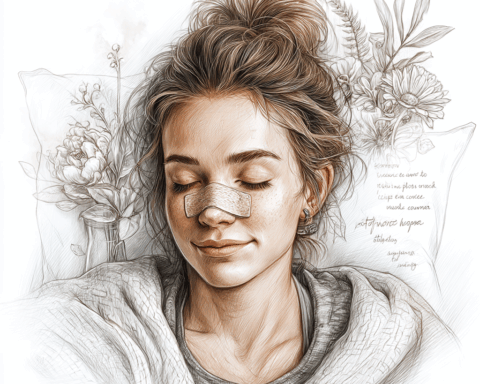Introduction
Facial harmony is not just about a pleasant combination of features; it is a complex balance where every detail matters. In this context, rhinoplasty (nose surgery) and orthodontic correction (bite correction) become essential tools for achieving the desired outcome. The various aspects of our faces are not isolated from each other: the shape of the nose directly influences the perception of the bite, and vice versa. Often, patients who wish to alter their appearance overlook that disharmony may not only be related to the nose but also to the improper position of the jaws. Thus, the importance of a comprehensive approach to facial harmonization becomes clear.
The Relationship Between Rhinoplasty and Orthodontic Correction
While many of us view the nose and teeth as separate elements, they actually form a whole in facial anatomy. Research indicates that rhinoplasty and bite correction can interact. To achieve the best results, these aspects must be considered together. When a patient opts for rhinoplasty without accounting for the state of their bite, they risk obtaining results that do not meet their expectations.
When consulting with a specialist, it is crucial to identify the root of the problem. The disharmony of the face may be related not only to the shape of the nose but also to the improper positioning of the jaws. A professional consultation with an orthodontist can help determine whether bite correction is necessary before or alongside rhinoplasty. This approach can immediately shorten rehabilitation time and prevent the need for additional surgeries, making treatment more justified and effective.
When Planning Rhinoplasty
When it comes to rhinoplasty, it is important to consider all aspects. The surgery can address problems with the shape, size, and proportions of the nose but will not resolve issues related to the bite. Ignoring these concerns can lead to less than favorable outcomes. Rhinoplasty and bite correction should be viewed as interconnected elements, with the order of interventions being crucial.
Rhinoplasty is a serious procedure that requires a lengthy recovery. The first ten days following the surgery are dedicated to rehabilitation, during which swelling and increased sensitivity may occur. It is important to understand that rhinoplasty does not resolve bite issues, and if performed hastily, unexpected complications may arise.
Modern Methods of Bite Correction
There are numerous methods for bite correction, ranging from traditional braces to modern aligners. The choice of method depends on the type of irregularity and the individual characteristics of the patient. If you are considering rhinoplasty, you should also consult with an orthodontist to confirm the need for bite correction.
Common bite irregularities include:
- Biprongnathic bite — the upper and lower incisors are tilted forward.
- Distal bite — the lower jaw is misaligned backward relative to the upper jaw.
- Deep bite — the upper teeth overlap the lower teeth.
Each of these conditions can significantly affect the overall profile of the face and create a sense of disharmony, even if the shape of the nose is fine. The best results are achieved through a comprehensive approach. Orthodontic treatment can greatly enhance your appearance, and in some cases, even make rhinoplasty unnecessary, as the incorrect perception of the nose's shape is often related to the improper positioning of the jaws.
Orthodontic Methods
Among the methods of correction, we can highlight:
-
Braces: the traditional method that effectively addresses most bite irregularities. They are affordable and allow for outcome prediction.
-
Aligners: these are clear removable trays that gently move the teeth. They are aesthetically pleasing and comfortable, though they may not be suitable for all cases.
-
Orthopedic appliances: various devices used for bite correction, especially in cases without significant gaps between the teeth.
-
Orthognathic surgery: in complex instances, surgical intervention may be necessary to change the positioning of the jaws.
Changing the Bite and Perception of the Nose
The perception of the nose can significantly change after bite correction. Many patients report that their nose looks different, even if no procedures were done on it. This is due to the change in the relationship of the facial features resulting from normalizing the position of the jaws.
Patients suffering from a distal bite often have a "protruding" profile, where the nose visually appears larger than it is. After treatment, this profile becomes more harmonious, and the nose may seem more proportional. Thus, the issue with the visual perception of the nose's shape may turn out to be a consequence of bite irregularities.
A Comprehensive Approach to Rhinoplasty and Bite Correction
In an ideal scenario, planning aesthetic changes to the face should involve consultations with several specialists: a plastic surgeon, an orthodontist, and, if necessary, a maxillofacial surgeon. This interdisciplinary approach can significantly improve patient satisfaction.
The parameters of the sequence of interventions are important for achieving the best results. It is often recommended to start with orthodontic treatment to change the position of the teeth and jaws, as this can greatly influence the perception of the nose. If orthognathic surgery is needed, rhinoplasty is performed later, once the face has acquired its new proportions.
Advantages of a Comprehensive Approach
A comprehensive approach to aesthetic facial correction offers the following advantages:
- A harmonious and balanced result.
- The resolution of both aesthetic and functional issues.
- Reduced risk of dissatisfaction with the results.
- Long-term maintenance of the achieved results.
Aligners or Rhinoplasty?
Modern patients are increasingly viewing orthodontic treatment as an alternative to plastic surgery. While aligners cannot replace rhinoplasty in cases specifically related to the nose, they can significantly alter the perception of the face as a whole.
After successful bite correction with aligners, many patients notice that their overall facial expression becomes more proportional, and their profile more refined. All this is achieved without surgeries or implants, with minimal discomfort for the patient. It is important to remember that the changes occur gradually, allowing for an adjustment to the new appearance.
Psychological Aspects of a Comprehensive Approach
The decision to change one's appearance is inevitably linked to psychological aspects. Patients seeking aesthetic correction often have specific expectations that may not align with reality. The hope that rhinoplasty will solve all external appearance issues can ultimately lead to disappointment.
It is advisable to form realistic expectations and always remember that a comprehensive approach is often necessary. Sustainable results are achieved through a gradual change in appearance, which is psychologically more comfortable than a sudden transformation following a single operation.
Clinical Cases: Successful Comprehensive Approach
Many patients who initially planned only for rhinoplasty decide, after consultations with doctors, to start with bite correction. Often, after completing orthodontic treatment, they notice that their nose looks significantly better with the newly aligned jaws. Some even fully forgo rhinoplasty, realizing that the problem was not the shape of the nose but rather its perception.
In cases where both procedures are necessary, well-planned sequential treatment leads to harmonious results. Many patients report improvements not only in appearance but also in functional aspects, such as breathing and chewing.
Technological Innovations in Treatment
Modern technologies make the planning of comprehensive treatment more precise and predictable. The use of 3D modeling allows for visualization of the expected outcomes of both orthodontic treatment and rhinoplasty. This gives patients the opportunity to see in advance what their face will look like after all interventions.
Digital treatment planning, using specialized software, allows orthodontists and plastic surgeons to collaboratively develop a treatment strategy. A precise and predictable assessment of results will enhance patient satisfaction.
Conclusion
Rhinoplasty and bite correction are powerful tools for achieving facial harmony that, when combined correctly, can yield exceptional results. A comprehensive approach that considers the interconnectedness of all facial structures allows for not only aesthetic perfection but also functional comfort.
Every patient is unique, and there are no universal solutions. Only thorough diagnostics and individual treatment planning involving a team of specialists can guarantee optimal results. If you are considering aesthetic corrections to your face, start with consultations from multiple specialists. Remember, facial harmony lies not only in a beautiful nose but also in the right proportions of all its elements, including the positioning of the jaws and teeth.
Do you want to keep up to date with the latest news about plastic surgery? Subscribe to my Telegram channel: https://t.me/By_Staisupov_ENG
Do you like to watch videos? More useful information is available here (the channel is in Russian, but you can always turn on auto-titles): https://www.youtube.com/@staisupov
All the results of plastic surgery can be found here: https://staisupov.com/results







